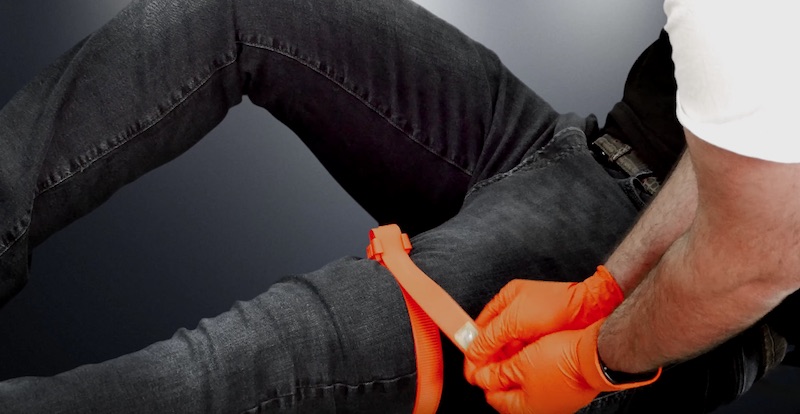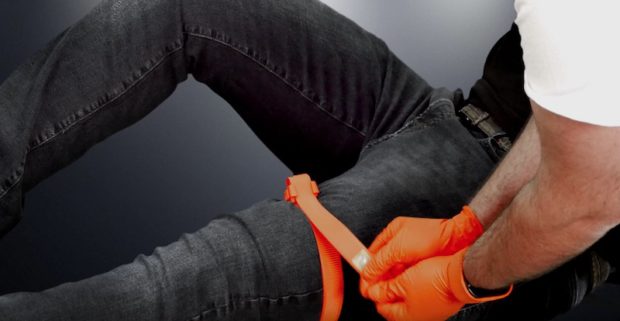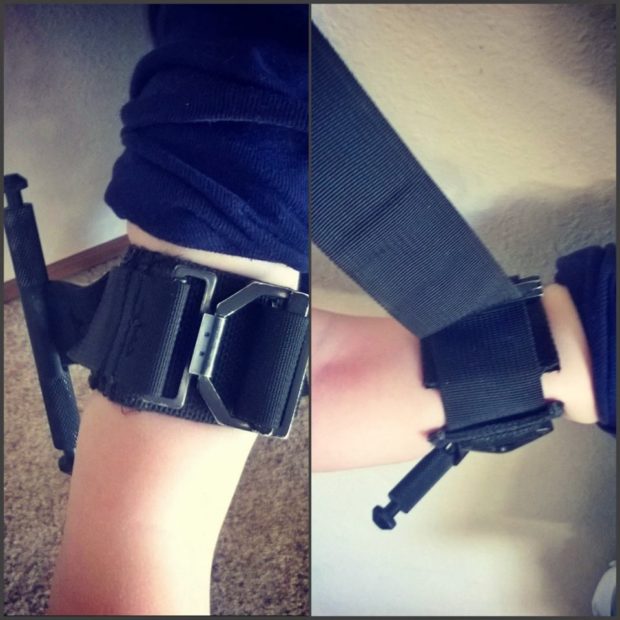I’ve been getting about five messages a day for the last week asking me about this new STAT “Ziptie” Tourniquet. Since I cannot deliver a throat punch via the internet, let’s have a little discussion about it. Here’s my take on the STAT Tourniquet.
I have no direct experience at all with this product. I will note however, that tourniquets without a windlass have historically performed poorly in military studies.
It also doesn’t have the approval of the Committee on Tactical Combat Casualty Care. That group contains all the true rock stars of emergency trauma medicine. They have access to the best information on the planet and they have not approved this new tourniquet for use by our military branches.
The STAT may work fine, but at this point, there isn’t any significant scientific evidence demonstrating that it is effective in real world conditions. If the COTCCC approves the tourniquet some time in the future, I will heartily recommend it. For now I wouldn’t touch it with a 10 foot pole.
There are some videos on YouTube showing that the STAT tourniquet adequately stopped circulation when applied to a single patient’s leg.
That’s awesome, but it’s not good enough.
Tourniquets must occlude distal blood flow to be effective. That’s the bare minimum performance standard. Almost all of the commercially available tourniquets will stop bleeding on some people some of the time. That’s not the tourniquet’s sole performance objective.
I could probably put any tourniquet (including the STAT) on someone in a classroom setting and pull it tight enough to shut down distal blood flow, even when measured by doppler ultrasound. Quite simply, that’s what a tourniquet is designed to do.
After we establish that it is generally able to stop extremity blood flow, then we start asking the more difficult questions:
– Will it stop all blood flow on all sizes of limbs? Will it work on big thighs? Statistically any limb larger than 25″ in circumference will require more than one tourniquet. Is this one better or worse than others in terms of stopping blood flow on muscular or obese patients?
-How quickly can it be put on?
– Will it work when I try to apply it to myself with slippery, blood-covered hands while I go into hypovolemic shock?
– Will it stay tight during the rough handling of a patient evacuation?
-Will it stay on during aggressive movement in a fight?
-Will it rigorously resist environmental conditions such as rain, snow, ice, and mud?
-How much pain does it create for the patient when applied? A narrow tourniquet band usually causes more pain than the wider versions.
– Will it resist bright sun light and heat (which regularly degrade plastic)?
– Will a long duration application cause any nerve or tissue damage?
– If the tourniquet is applied incorrectly due to stress or poor training, will it cause the patient further harm?
No one knows the answers for these questions with regards to the STAT tourniquet. It’s new. Those tests haven’t been conducted.
As I stated above, almost all the tourniquets on the market will occlude blood flow in ideal conditions. A lot of them fail in regards to the issues I raised above. Just because you can get a tourniquet to work in a single application during a stress-free classroom training session doesn’t mean it’s a good tourniquet.
If you need a tourniquet, you are in danger of bleeding to death. When death is the consequence of a poor product performance, I tend to buy the best gear possible. Why take a chance on something new when there are already products that have a proven track record in combat available for less than $30 each?
Is your life worth so little that you would gamble on something like a new, untested tourniquet when a slightly more expensive (but combat-proven) CAT or SOFT-T is readily available?
“Cheap and easy” is not the criteria I’m looking for when purchasing life saving gear.

Here is the bottom line with tourniquets: The CAT and the SOFT-T Wide are the only ones with approval from the Committee on Tactical Combat Casualty Care.
They are the only ones I would use.
Full stop.
What about Kids?
A lot of folks justify their alternate tourniquet choices by stating that the COTCCC-approved tourniquets don’t tighten small enough to reliably occlude the blood vessels of very small children and/or pets. That simply isn’t true. It’s marketing disinformation from the elastic tourniquet companies purposely designed to prey on the fears of parents and pet owners.
The CAT and the SOFT-T have recently been proven to work on children. Take a look at the studies referenced in Do commercially available tourniquets work on kids? From the article:
“Dr. John Kragh, an orthopedic surgeon and military researcher on tourniquet use, studied 88 children seen in US Military Hospitals in Iraq and Afghanistan on whom US DOD tourniquets were placed. Children ranged in age from 4 to 17 years old. 64% were injured by explosions and 30% gunshot wounds. 7 of the 88 died. They identified no pediatric-specific problems in applying the tourniquets on kids despite the tourniquets being designed for adult casualties. The tourniquets seemed to work on kids just fine.”
The complete study referenced above is the Survey of Trauma Registry Data on Tourniquet Use in Pediatric War Casualties.
An even more inclusive study Pediatric Extremity Hemorrhage and Tourniquet Use in the Journal of EMS reviewed of all the literature on the topic of pediatric tourniquet use as well as looked at average limb size in kids broken down by age group.
The Pediatric Appendix of the Tactical Combat Casualty Care guidelines supports the use of the CAT and SOFT-T on children.
Bottom line? The CAT and the SOFT-T work on both children and infants. The Pediatric Trauma Society position statement also supports the use of commercial tourniquets in pediatric patients.
What about pets?
It’s exceptionally rare to use a tourniquet on a house cat. In all of Dr. Lauren Pugliese’s veterinary clinical experience, she’s never seen a single situation where a tourniquet has been applied to a cat outside of an operating room setting.
Cats don’t have a large blood volume. When they get arterial damage, they tend to die very quickly. For more info on that topic, take a look at Dr. Lauren’s article on feline emergency veterinary care titled: The Cat’s Out of the Bag.
How about dogs?
Correct tourniquet placement on a dog leg is very high on the hip/shoulder. CATs and SOFT-Ts will work at this location even on small dogs. Take a look at the photo below illustrating proper dog tourniquet placement.

Proper tourniquet placement sites for dog limbs
The problem with the use of any tourniquet on a dog’s leg is that the leg is funnel shaped. Tourniquets placed high up on the limb tend to slip downward, causing reduced efficacy for bleeding control. There are no scientific studies showing that an elastic tourniquet will reduce such slipping any better than a CAT or SOFT-T. For more information on that subject, read Dr. Pugliese’s article on Controlling Life Threatening Bleeding in Dogs.
Research indicates that tourniquets may be of some utility in dogs, but the situations where tourniquets are effective are somewhat rare.
“Although tourniquet application is a life-saving intervention in humans experiencing extremity hemorrhage, it is not considered a necessary, immediate-action life-saving intervention for canines with extremity injuries.”
Clinical Update: Concepts of Prehospital Traumatic Hemorrhage Control in the Operational K9, Journal of Special Operations Medicine
Palmer LE. 18(4). 123 – 130. (Journal Article)
Have I convinced you that you should only use a COTCCC-approved tourniquet? If not, you may want to check out the articles, videos, and scientific studies I link to below:
STAT Tourniquet: 21 of 24 applications FAIL
The new SAM SXT tourniquet is not superior to the CAT.
TMT Tourniquet not Superior to CAT
RATS and TMT tourniquets Inferior to CAT
Detecting Counterfeit CAT Tourniquets
CAT Performs Better than improvised tourniquets
Tactical Mechanical Tourniquet not Better than CAT
Tourniquets: Where the science stands
Is the R.A.T.S. Tourniquet Misleading Consumers with TCCC Approval?
National EMT Association Guidelines Recommend Only CAT and SOFT-T
SWAT-T Takes Approximately Twice as Long to Apply as Compared to CAT
Pediatric Extremity Hemorrhage and Tourniquet Use
Officer Uses a CAT Tourniquet to Save a Baby’s Life
The STAT tourniquet may work very well. We just don’t know for sure at this point in time. I personally wouldn’t carry an unproven tourniquet design when better options are readily available.





